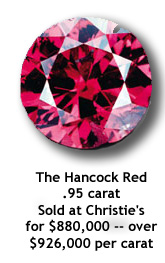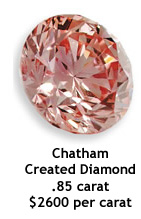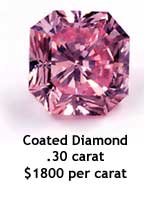Diamonds Wear Coats of Many Colors
To meet the growing demand for low-priced colored diamonds, technology has come up with a new version of an old trick:
coating the diamond to change its color.
 Intensely colored diamonds, called fancies, are extremely rare in nature and very expensive. The gem industry has overcome these limitations in recent years by developing ways to produce colored diamonds at a comparatively low cost.
Intensely colored diamonds, called fancies, are extremely rare in nature and very expensive. The gem industry has overcome these limitations in recent years by developing ways to produce colored diamonds at a comparatively low cost.
In earlier issues we’ve discussed some of these technologies. Colored diamonds can be synthesized in a lab. Or, poorly colored natural diamonds, yellowish or brownish stones, can be turned to vivid colors through irradiation and HPHT (high pressure high temperature). Or, the diamond can be coated.
Coating diamonds to change their color is hardly a new practice. For centuries merchants would paint a gem with a thin layer of some foreign substance to create a more desirable appearance. However, earlier coating methods were comparatively crude, easily detected and not permanent.
 The new methods are much more sophisticated. Annealing the coating through high temperature and pressure can give diamonds strongly saturated, natural-looking colors, such as blue, green, yellow, orange, pink and purple-pink. Nanotechnology is used to make a coating film that is highly resistant to abrasion and fairly durable in color.
The new methods are much more sophisticated. Annealing the coating through high temperature and pressure can give diamonds strongly saturated, natural-looking colors, such as blue, green, yellow, orange, pink and purple-pink. Nanotechnology is used to make a coating film that is highly resistant to abrasion and fairly durable in color.
Detection & Disclosure
Detecting the coatings is a challenge even for trained gemologists specifically charged with that task. The technologies vary and the coatings are proprietary.
A coating is especially hard to detect if it is applied below the stone’s girdle, to the area of the gem that’s usually concealed in a setting. When viewed from above, the diamond takes color from the coating. The coating might not be evident even to a trained gemologist unless he removes the stone from the setting.
 Some suppliers openly disclose the treatment, others do not. One supplier of coated diamonds describes its stones as “infused” or “HPHT-treated,” but this terminology is inaccurate and misleading.
Some suppliers openly disclose the treatment, others do not. One supplier of coated diamonds describes its stones as “infused” or “HPHT-treated,” but this terminology is inaccurate and misleading.
Even if the supplier discloses the treatment, carelessness or fraud can occur anywhere down the chain of sale before the stone reaches the customer.
Durability
The long-term durability of such coatings is questionable. Since various methods are used, diamonds from different suppliers may have different qualities.
The Gemological Institute of America (GIA) Laboratory studied a large number of coated stones from Serenity Technologies. GIA found that exposing the gems to some common household cleaners, such as bleach, caused the color to lighten, and that rubbing them with an abrasive powdered kitchen cleanser damaged the coating. Though damage does not happen easily, it could occur over time through normal wear.
FOR AGENTS & UNDERWRITERS
Coating is a color treatment, and treated diamonds are worth vastly less than untreated natural diamonds of similar appearance.
In insuring colored diamonds, never assume they are natural and untreated. Insist on an appraisal that explicitly states whether the gems are natural or synthetic, and whether natural gems are treated or untreated.
Be aware that the new coatings are difficult to detect, even by experienced gemologists. Jewelers without gemological training might not even look for a coating. Be sure the appraisal is written by a Graduate Gemologist (GG) who is also a Certified Insurance Appraiser™ (CIA).
Vivid-colored “fancy” diamonds are extremely rare in nature and very expensive. A selling price that seems “too good to be true” is a strong indication that a colored diamond is either treated or synthetic.
Do insurance to value (ITV) calculations to check for a large discrepancy between purchase price and replacement cost. Software is available that makes ITV easy and guards against fraud.
Any colored diamond approaching .5 carat should come with a certificate from a reputable independent laboratory, such as the Gemological Institute of America (GIA) or the American Gem Society (AGS).
For all high-value jewelry, it is best to have two appraisals. At least one of them should be written on JISO 78/79, the insurance industry’s standard, by a Graduate Gemologist (GG) who is also a Certified Insurance Appraiser™ (CIA). JISO 805 or JISO 806 may be used by a jeweler/appraiser who is not a GG and CIA.
FOR ADJUSTERS
Check the appraisal closely for terms indicating gem treatments, such as coated, infused, treated, enhanced, HPHT, and irradiated.
Natural, untreated fancies are extremely rare. The difference in value between natural fancies and color-treated stones is enormous.
An appraisal for colored diamond should explicitly state that the stone is either natural or synthetic. If natural, the appraisal should either state that the diamond is untreated or should list the treatments. Be especially cautious if the appraisal is not explicit on these points.
Be suspicious if you are working from a Diamond Certificate/Report that carries a valuation. Reputable grading labs (such as GIA and AGS) report only on the qualities of the gem; they do not include valuation. Also, they do not issue reports on coated stones.
For damaged jewelry, have the jewelry inspected in a gem lab by a Graduate Gemologist who is also a Certified Insurance Appraiser™. You want to be sure that the “damage” is not the result of a color treatment breaking down.
Damaged jewelry should always be inspected in a gem lab to verify that the gem was of the quality stated on the appraisal. Obviously, the higher the valuation, the more important is this precautionary step.
©2000-2025, JCRS Inland Marine Solutions, Inc. All Rights Reserved. www.jcrs.com

